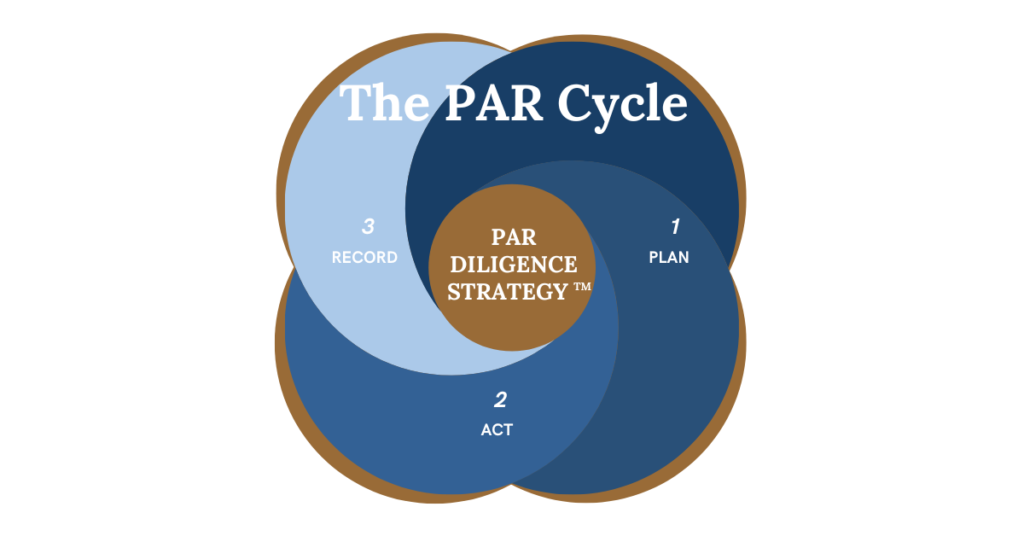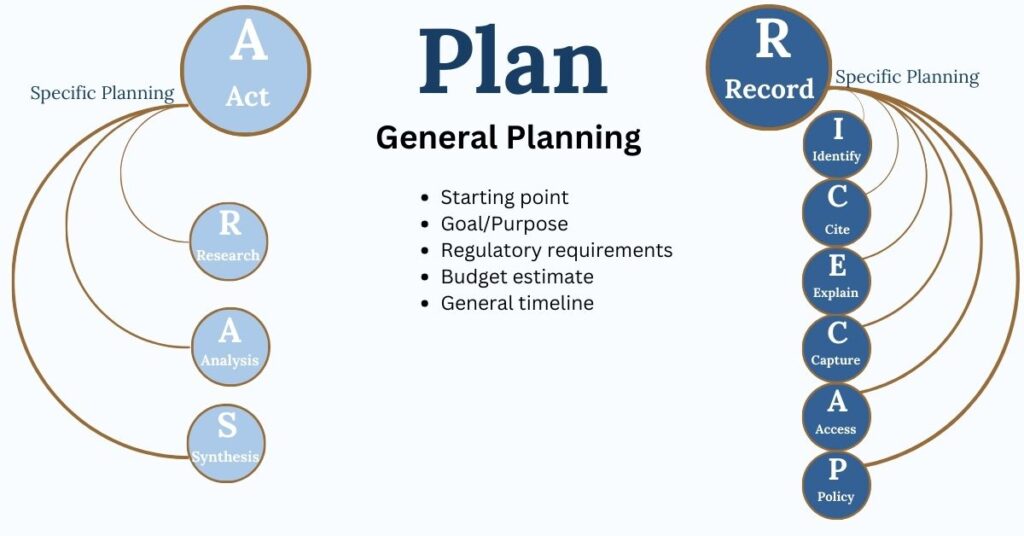Jun 1, 2024
The Secret To Great Diligence – Start with a Plan
PAR Diligence StrategyPlan

Planning each step of diligence builds efficiency, logic and transparency into the diligence process. A plan provides you with a start and an end and insures more accurate and useful results. If you want great diligence don’t skip the plan.
“Before anything else, preparation is the key to success.” ― Alexander Graham Bell, inventor
The secret to great diligence is a great plan.
Taking the time to plan does not mean you are being rigid, lacking in creativity or ticking a box. Planning means you are taking the time to:
– define your goal
– understand your starting point
– map out the actions and steps that will take you to the goal
– establish the parameters (for example, deadlines, budgets, regulatory and internal policies) that apply to your project
And while each diligence project needs its own plan you can define standards, incorporate past knowledge and use planning tools that will make the planning process efficient.

The Travel Metaphor
Have you ever tried to go from New York, the east coast of the US, to California, the west coast of the US, by taking a series of buses going west? I mean random buses.
You go to the nearest bus station/stop and get on the first bus headed westbound. Any bus – local, interstate, long distance – as long as it is going west. Each time the bus reaches the end of the route you find another bus pointed west. You keep dong this until you cross a border into California.
Would you do this? Probably not. Why not, because it is absurd!
Traveling this way:
- Ignores time and budget considerations
- Sets no useful goal; California is the third largest US state at about 163,696 square miles so you can be in California but far from where you would like to visit
- Is inefficient
- Exposes you to unnecessary risks perhaps even danger
- May leave you frustrated, exhausted and bored
Instead, when most people travel they:
- Set a timeline
- Choose a destination
- Forumlate a budget
- Identify preferences and parameters for
- Consider contingencies and risks
In other words, they make a PLAN.
Planning a Diligence Project is Like Planning Travel
You want to plan diligence to increase your risk of success and reduce your risk of failure. Without a plan you risk:
- Not finding what you need
- Being unsure of the quality of the material
- Using “bad material”
- Becoming overloaded with information
- Missing something important
- Failing to comply with requirements
- Being unable to replicate your results
- Failing to properly document your process and results
To reduce the risk of these outcomes and for your diligence to be:
- Efficient
- Cost effective
- Timely
- Manageable
- Comprehensive
- Logical
- Compliant
- Transparent
- Replicable
you need a Diligence Plan.
How do you do this? Try using the elements of the PAR Cycle.

The Diligence File PAR Strategy
The Diligence File Strategy – PAR – is a way to conduct and organize diligence projects. The initials stand for – PLAN – ACT – RECORD and while planning is listed as a first step, planning actually applies to all the steps taken at various points in the diligence cycle. If you are using the PAR elements you would begin by:
- General Planning – This is where you define parameters that apply to the entire project such as:
- setting your goal and purpose for the diligence and identifying your starting point.
- taking account of regulatory and internal requirements
- establishing a budget
- laying out a timeline including deadlines for each action step
- Specific Planning – This is where you define specific criteria that apply to each element of the Act and Record Actions in the PAR strategy.
- Act represents the actions of – Research – Analysis – Synthesis. For each of these steps you would lay out the particular goals and measures that will accomplish the goal. For example, if you are planning your research you would amount other criteria, set out the acceptable criteria for sources.
- Record represents a number of actions around the process of – Identify – Cite – Explain – Capture – Access – Policy. Each of these actions is defined based on your project and your requirements such as regulatory mandates and internal policy so there would be a plan for each, which may simply be following a pre-established set of processes.
This is a visual representation of these elements:


Tools
The key to easier planning is to develop and reuse planning tools. These tools are based on your prior experience as well as technology available to you. The idea is that when you use these tools you are saving yourself time by not “reinventing the wheel” for each project.
These tools may be simple or technologically advanced, depending on your budget and organization. Some examples include:
- Checklists that apply to all projects or different project types
- Directories and collections of previously evaluated sources and sites
- Internal and external guidelines and policies (for example, regulatory notices, guidelines or directives, documentation and archival policies)
- Contacts for internal or external diligence professionals or subject matter experts (for example, research librarians, compliance or audit professionals, internal and external lawyers)
- Internal technology systems such as knowledge management, customer relationship, sales and compliance systems

Some Additional Thoughts
> Keep it simple, use planning to make your diligence process more efficient and complete not to add complexity
> Don’t use planning to enforce rigidity and inflexible thinking
> In the plan include administrative and internal requirements such as evaluations, sign offs and reviews
> Allow for creativity in developing the plan and when in use
> Don’t make a plan then fail to use it
> When using the plan, work through the steps but allow for flexibility
> Don’t fail to follow up on any results
> Don’t allow the planning process to overwhelm the diligence process – the plan is the start not the end of each diligence step
> If you have access to technology – great – but even complex diligence projects can be planned with a paper and pencil
“We should remember that good fortune often happens when opportunity meets with preparation” ― Thomas Alva Edison, inventor
Sign Up to Receive the Diligence File Emails – More Ideas & Resources to Advance Your Diligence
Thank you


Subscribe for Diligence Updates
Get the latest updates, resources, offers, and more.
"*" indicates required fields
The Diligence File respects your privacy. Privacy Policy